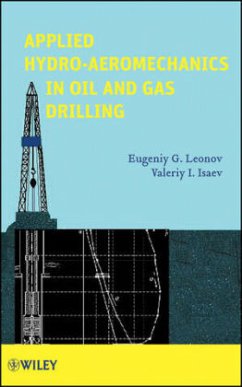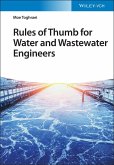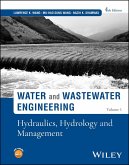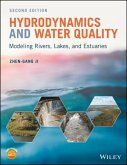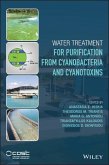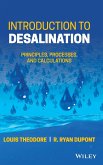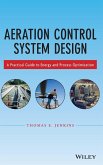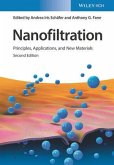- Gebundenes Buch
- Merkliste
- Auf die Merkliste
- Bewerten Bewerten
- Teilen
- Produkt teilen
- Produkterinnerung
- Produkterinnerung
An all-in-one reference combining hydrodynamic theory with drilling applications for the design, planning, and optimization of drilling operations
Hydromechanical processes underlie the majority of technology operations in drilling and present a crucial concern as the pace and depth of drilling increasesin today's energy-hungry world. Applied Hydro-aeromechanics in Oil and Gas Drilling offers a unique resource for properly modeling and understanding the hydro-dynamic forces affecting a drilling site. Combining hydrodynamic theory with specific drilling applications, this coverage provides…mehr
Andere Kunden interessierten sich auch für
![Rules of Thumb for Water and Wastewater Engineers Rules of Thumb for Water and Wastewater Engineers]() Moe ToghraeiRules of Thumb for Water and Wastewater Engineers95,99 €
Moe ToghraeiRules of Thumb for Water and Wastewater Engineers95,99 €![Water and Wastewater Engineering, Volume 1 Water and Wastewater Engineering, Volume 1]() Lawrence K. WangWater and Wastewater Engineering, Volume 189,99 €
Lawrence K. WangWater and Wastewater Engineering, Volume 189,99 €![Hydrodynamics and Water Quality Hydrodynamics and Water Quality]() Zhen-Gang JiHydrodynamics and Water Quality200,99 €
Zhen-Gang JiHydrodynamics and Water Quality200,99 €![Water Treatment for Purification from Cyanobacteria and Cyanotoxins Water Treatment for Purification from Cyanobacteria and Cyanotoxins]() Water Treatment for Purification from Cyanobacteria and Cyanotoxins187,99 €
Water Treatment for Purification from Cyanobacteria and Cyanotoxins187,99 €![Introduction to Desalination Introduction to Desalination]() Louis TheodoreIntroduction to Desalination192,99 €
Louis TheodoreIntroduction to Desalination192,99 €![Aeration Control Aeration Control]() Thomas E. JenkinsAeration Control129,99 €
Thomas E. JenkinsAeration Control129,99 €![Nanofiltration Nanofiltration]() Nanofiltration262,99 €
Nanofiltration262,99 €-
-
-
An all-in-one reference combining hydrodynamic theory with drilling applications for the design, planning, and optimization of drilling operations
Hydromechanical processes underlie the majority of technology operations in drilling and present a crucial concern as the pace and depth of drilling increasesin today's energy-hungry world. Applied Hydro-aeromechanics in Oil and Gas Drilling offers a unique resource for properly modeling and understanding the hydro-dynamic forces affecting a drilling site. Combining hydrodynamic theory with specific drilling applications, this coverage provides readers with a comprehensive reference for designing, planning, and optimizing drilling operations.
Featuring the latest technologies and developments affecting the field, Applied Hydro-aeromechanics in Oil and Gas Drilling covers topics including:
The physics of hydro-aeromechanical phenomena in drilling processes
Calculation methods for understanding and designing circulation systems for the washing, blasting, and cementing of wells
Problems of interaction between wells and reservoirs
Problems with the fluid, gas, and liquid-gas mixture flows necessary in designing and building of wells
Presenting an unmatched combination of theory, modeling issues, and concrete, illustrative examples, Applied Hydro-aeromechanics in Oil and Gas Drilling bringstogether formerly widespread technical information to offer a systematic and methodical guide. It is an essential reference for both students and researchers studying fluid mechanics, as well as engineers and other professionals working in the oil and gas industry.
Hinweis: Dieser Artikel kann nur an eine deutsche Lieferadresse ausgeliefert werden.
Hydromechanical processes underlie the majority of technology operations in drilling and present a crucial concern as the pace and depth of drilling increasesin today's energy-hungry world. Applied Hydro-aeromechanics in Oil and Gas Drilling offers a unique resource for properly modeling and understanding the hydro-dynamic forces affecting a drilling site. Combining hydrodynamic theory with specific drilling applications, this coverage provides readers with a comprehensive reference for designing, planning, and optimizing drilling operations.
Featuring the latest technologies and developments affecting the field, Applied Hydro-aeromechanics in Oil and Gas Drilling covers topics including:
The physics of hydro-aeromechanical phenomena in drilling processes
Calculation methods for understanding and designing circulation systems for the washing, blasting, and cementing of wells
Problems of interaction between wells and reservoirs
Problems with the fluid, gas, and liquid-gas mixture flows necessary in designing and building of wells
Presenting an unmatched combination of theory, modeling issues, and concrete, illustrative examples, Applied Hydro-aeromechanics in Oil and Gas Drilling bringstogether formerly widespread technical information to offer a systematic and methodical guide. It is an essential reference for both students and researchers studying fluid mechanics, as well as engineers and other professionals working in the oil and gas industry.
Hinweis: Dieser Artikel kann nur an eine deutsche Lieferadresse ausgeliefert werden.
Produktdetails
- Produktdetails
- Verlag: Wiley & Sons
- 1. Auflage
- Seitenzahl: 472
- Erscheinungstermin: 1. November 2009
- Englisch
- Abmessung: 236mm x 155mm x 25mm
- Gewicht: 748g
- ISBN-13: 9780470487563
- ISBN-10: 0470487569
- Artikelnr.: 27138278
- Herstellerkennzeichnung
- Libri GmbH
- Europaallee 1
- 36244 Bad Hersfeld
- gpsr@libri.de
- Verlag: Wiley & Sons
- 1. Auflage
- Seitenzahl: 472
- Erscheinungstermin: 1. November 2009
- Englisch
- Abmessung: 236mm x 155mm x 25mm
- Gewicht: 748g
- ISBN-13: 9780470487563
- ISBN-10: 0470487569
- Artikelnr.: 27138278
- Herstellerkennzeichnung
- Libri GmbH
- Europaallee 1
- 36244 Bad Hersfeld
- gpsr@libri.de
Eugeniy Leonov is Professor at Moscow State University of Oil and Gas in the Department of Drilling of Oil and Gas Wells. Valeriy Isaev is Associate Professor at Moscow State University of Oil and Gas, in the Department of Oil-Gas and Reservoir Hydromechanics.
Preface. Notation. 1 Main results and development lines in hydro-aeromechanics of drilling processes. 2 Basic problems of hydro-aeromechanics in drilling processes. 3 Multiphase media in drilling processes. 4 Hydro- aeromechanic equations in drilling processes. 4.1 Mass conservation equation. 4.2 Momentum (motion) equation. 4.3 Thermodynamic equations of state. 4.4 Rheological equations of state. 4.5 Equation of concentrations. 4.6 Formulation of hydro-aerodynamic problems for drilling processes. 5 Hydrostatics of single-phase fluids and two-phase mixtures in gravity field. 5.1 Hydrostatics of single-phase fluids. 5.2 Hydrostatics of incompressible fluid at
w = 0. 5.3 Hydrostatics of single-phase compressible fluid (gas) at
w = 0. 5.4 Hydrostatics of slightly compressible fluid
w = 0. 5.5 Hydrostatics of a fluid with dynamic shear stress (
w
0). 5.6 Hydrostatics of two-phase fluids. 6 Stationary flow of fluids in elements of well circulation system. 6.1 Equations for stationary flows of homogeneous incompressible fluids. 6.2 Calculation of pressure in laminar flows of viscous incompressible fluids in circular slots, pipes and annular channels. 6.3 Calculation of pressure in laminar flow of viscous-plastic fluids in circular slots, pipes and annular channels. 6.4 Calculation of pressure in laminar flow of power incompressible fluids in circular slots, pipes and annular channels. 6.5 Calculation of pressure in turbulent flow in circular pipes and annular channels. 6.6 Transition of laminar flow of viscous, viscous-plastic and power fluids into turbulent one. 6.7 Calculation of pressure in eccentric annulus. Formation of stagnation zones. 6.8 Effect of internal pipe rotation on pressure in annulus. 6.9 Pressure drop in local resistances of circulation system. 7 Equilibrium and motion of rigid particles in fluid, gas and gas-liquid mixture. 7.1 Washing of the well bottom. 7.2 Levitation of rigid particles in fluid, gas and gas-liquid flows. 7.3 Flow rate of fluid, gas and gas-liquid mixture needed for removal of cutting from well bore. 7.4 Calculation of ball drop time in descending flow of washing fluid in a column of pipes. 7.5 Hydraulic calculation of a circulation system in drilling with incompressible washing fluid. 8 Stationary flow of gas and gas-cutting mixture in elements of well circulation system. 8.1 Pressure distribution in ascending flow of gas and gas-cutting mixture in annular channel of a well. 8.2 Pressure distribution in descending flow of gas in pipes. 8.3 Pressure losses in bit heads and pipe joints. 8.4 Calculation procedure of pump capacity and compressor pressure in drilling with blasting. 9 Stationary flows of gas-liquid mixtures in a well. 9.1 Equations of gas-liquid mixture flow. 9.2 Laminar ascending flow of gas-liquid mixtures in pipes and annular channels. 9.3 Calculation of pressure in pipes and annular space in ascending vertical turbulent flows of gas-liquid mixtures. 9.4 Pressure drop in bit heads in flow of gas-liquid mixture. 9.5 Pressure drop in turbo-drills. 9.6 Calculation of pressure in pipes in descending vertical turbulent flow of gas-liquid mixture. 9.7 Method of calculation of delivery and pressure of pumps and compressors in drilling with aerated fluid washing. 9.8 Effect of gas solubility in fluid on pressure of a mixture in a well. 10 Non-stationary flows of single-phase fluids in a well. 10.1 Equations for non-stationary single-phase flows. 10.2 Non-stationary flows of incompressible fluid in round trip operations. 10.3 Hydrodynamic pressure in round trip operation in a well filled by viscous fluid. 10.4 Hydrodynamic pressure generated by drill-stem descent in a well filled by viscous-plastic fluid. 10.5 Examples of pressure calculations in round trip operations. 10.6 Non-stationary fluid flow in a well as wave process. 10.7. Pressure calculation in deterioration of the safety bypass. 10.8 Calculation of pressure in recovery of circulation in a well. 10.9 Calculation of pressure in a well in settling of ball cage on a seat (thrust ring) in drill-stem. 10.10 Calculation of pressure in round trip of a drill-stem as wave process. 11 Flows of formation fluids and rock solids. 11.1 Basic equations of fluid and rock solid flows. 11.2 Stationary laminar flows of incompressible and compressible fluids and gases. 11.3 Nonstationary laminar flows of incompressible and compressible fluids and gases. 11.4 Flows of formation fluids and rock solids at regimes different from laminar. 12 Nonstationary flow of gas-liquid mixtures in well-formation system. 12.1 Estimation of bottom-hole decompression in removal of gas bench from a well. 12.2 Recognition of gas outburst and selection of regimes of its liquidation. 12.3 Calculation of amount, density and delivery of fluid needed to kill the open gas blowout. 12.4 Calculation of pressure at the well mouth in blowout killing by direct pumping of killing fluid into the well. 13 Nonstationary flows of fluid mixtures in well-formation system Calculation of fluid-gas blowout killing. 14 Distribution of concentration and pressure in displacement of Newtonian and viscous-plastic fluids from circular pipes and annular channels. Hydraulic calculation of cementation regime. 14.1 Main reasons of incompletely displacement of fluids. 14.2 Distribution of concentrations in displacement of one fluid by another fluid. 14.3 Taking into account needed displacement completeness in calculations of cementing. 14.4 Method of hydraulic calculation of cementing regimes with regard to given concentration in channel cross-section. 14.5 Calculation of single-stage well cementation. Method and calculation of cementation with foam-cement slurry. 15 Sedimentation of rigid phase in drilling fluid after deadlock of mixing. 15.1 One-dimensional equation for hydraulic pressure in sedimentation of rigid phase of suspension. 15.2 Lowering of hydraulic pressure in a well after deadlock of solution circulation. 16 Experimental determination of rheological characteristics. 16.1 Determination of rheological characteristics with rotary viscometer. 16.2 Determination of rheological characteristics with capillary viscometer. 16.3 Determination of rheological characteristics of rock solids. 16.4 Examples of application of rheological characteristics. References. Author index. Subject index. About the Authors.
w = 0. 5.3 Hydrostatics of single-phase compressible fluid (gas) at
w = 0. 5.4 Hydrostatics of slightly compressible fluid
w = 0. 5.5 Hydrostatics of a fluid with dynamic shear stress (
w
0). 5.6 Hydrostatics of two-phase fluids. 6 Stationary flow of fluids in elements of well circulation system. 6.1 Equations for stationary flows of homogeneous incompressible fluids. 6.2 Calculation of pressure in laminar flows of viscous incompressible fluids in circular slots, pipes and annular channels. 6.3 Calculation of pressure in laminar flow of viscous-plastic fluids in circular slots, pipes and annular channels. 6.4 Calculation of pressure in laminar flow of power incompressible fluids in circular slots, pipes and annular channels. 6.5 Calculation of pressure in turbulent flow in circular pipes and annular channels. 6.6 Transition of laminar flow of viscous, viscous-plastic and power fluids into turbulent one. 6.7 Calculation of pressure in eccentric annulus. Formation of stagnation zones. 6.8 Effect of internal pipe rotation on pressure in annulus. 6.9 Pressure drop in local resistances of circulation system. 7 Equilibrium and motion of rigid particles in fluid, gas and gas-liquid mixture. 7.1 Washing of the well bottom. 7.2 Levitation of rigid particles in fluid, gas and gas-liquid flows. 7.3 Flow rate of fluid, gas and gas-liquid mixture needed for removal of cutting from well bore. 7.4 Calculation of ball drop time in descending flow of washing fluid in a column of pipes. 7.5 Hydraulic calculation of a circulation system in drilling with incompressible washing fluid. 8 Stationary flow of gas and gas-cutting mixture in elements of well circulation system. 8.1 Pressure distribution in ascending flow of gas and gas-cutting mixture in annular channel of a well. 8.2 Pressure distribution in descending flow of gas in pipes. 8.3 Pressure losses in bit heads and pipe joints. 8.4 Calculation procedure of pump capacity and compressor pressure in drilling with blasting. 9 Stationary flows of gas-liquid mixtures in a well. 9.1 Equations of gas-liquid mixture flow. 9.2 Laminar ascending flow of gas-liquid mixtures in pipes and annular channels. 9.3 Calculation of pressure in pipes and annular space in ascending vertical turbulent flows of gas-liquid mixtures. 9.4 Pressure drop in bit heads in flow of gas-liquid mixture. 9.5 Pressure drop in turbo-drills. 9.6 Calculation of pressure in pipes in descending vertical turbulent flow of gas-liquid mixture. 9.7 Method of calculation of delivery and pressure of pumps and compressors in drilling with aerated fluid washing. 9.8 Effect of gas solubility in fluid on pressure of a mixture in a well. 10 Non-stationary flows of single-phase fluids in a well. 10.1 Equations for non-stationary single-phase flows. 10.2 Non-stationary flows of incompressible fluid in round trip operations. 10.3 Hydrodynamic pressure in round trip operation in a well filled by viscous fluid. 10.4 Hydrodynamic pressure generated by drill-stem descent in a well filled by viscous-plastic fluid. 10.5 Examples of pressure calculations in round trip operations. 10.6 Non-stationary fluid flow in a well as wave process. 10.7. Pressure calculation in deterioration of the safety bypass. 10.8 Calculation of pressure in recovery of circulation in a well. 10.9 Calculation of pressure in a well in settling of ball cage on a seat (thrust ring) in drill-stem. 10.10 Calculation of pressure in round trip of a drill-stem as wave process. 11 Flows of formation fluids and rock solids. 11.1 Basic equations of fluid and rock solid flows. 11.2 Stationary laminar flows of incompressible and compressible fluids and gases. 11.3 Nonstationary laminar flows of incompressible and compressible fluids and gases. 11.4 Flows of formation fluids and rock solids at regimes different from laminar. 12 Nonstationary flow of gas-liquid mixtures in well-formation system. 12.1 Estimation of bottom-hole decompression in removal of gas bench from a well. 12.2 Recognition of gas outburst and selection of regimes of its liquidation. 12.3 Calculation of amount, density and delivery of fluid needed to kill the open gas blowout. 12.4 Calculation of pressure at the well mouth in blowout killing by direct pumping of killing fluid into the well. 13 Nonstationary flows of fluid mixtures in well-formation system Calculation of fluid-gas blowout killing. 14 Distribution of concentration and pressure in displacement of Newtonian and viscous-plastic fluids from circular pipes and annular channels. Hydraulic calculation of cementation regime. 14.1 Main reasons of incompletely displacement of fluids. 14.2 Distribution of concentrations in displacement of one fluid by another fluid. 14.3 Taking into account needed displacement completeness in calculations of cementing. 14.4 Method of hydraulic calculation of cementing regimes with regard to given concentration in channel cross-section. 14.5 Calculation of single-stage well cementation. Method and calculation of cementation with foam-cement slurry. 15 Sedimentation of rigid phase in drilling fluid after deadlock of mixing. 15.1 One-dimensional equation for hydraulic pressure in sedimentation of rigid phase of suspension. 15.2 Lowering of hydraulic pressure in a well after deadlock of solution circulation. 16 Experimental determination of rheological characteristics. 16.1 Determination of rheological characteristics with rotary viscometer. 16.2 Determination of rheological characteristics with capillary viscometer. 16.3 Determination of rheological characteristics of rock solids. 16.4 Examples of application of rheological characteristics. References. Author index. Subject index. About the Authors.
Preface. Notation. 1 Main results and development lines in hydro-aeromechanics of drilling processes. 2 Basic problems of hydro-aeromechanics in drilling processes. 3 Multiphase media in drilling processes. 4 Hydro- aeromechanic equations in drilling processes. 4.1 Mass conservation equation. 4.2 Momentum (motion) equation. 4.3 Thermodynamic equations of state. 4.4 Rheological equations of state. 4.5 Equation of concentrations. 4.6 Formulation of hydro-aerodynamic problems for drilling processes. 5 Hydrostatics of single-phase fluids and two-phase mixtures in gravity field. 5.1 Hydrostatics of single-phase fluids. 5.2 Hydrostatics of incompressible fluid at
w = 0. 5.3 Hydrostatics of single-phase compressible fluid (gas) at
w = 0. 5.4 Hydrostatics of slightly compressible fluid
w = 0. 5.5 Hydrostatics of a fluid with dynamic shear stress (
w
0). 5.6 Hydrostatics of two-phase fluids. 6 Stationary flow of fluids in elements of well circulation system. 6.1 Equations for stationary flows of homogeneous incompressible fluids. 6.2 Calculation of pressure in laminar flows of viscous incompressible fluids in circular slots, pipes and annular channels. 6.3 Calculation of pressure in laminar flow of viscous-plastic fluids in circular slots, pipes and annular channels. 6.4 Calculation of pressure in laminar flow of power incompressible fluids in circular slots, pipes and annular channels. 6.5 Calculation of pressure in turbulent flow in circular pipes and annular channels. 6.6 Transition of laminar flow of viscous, viscous-plastic and power fluids into turbulent one. 6.7 Calculation of pressure in eccentric annulus. Formation of stagnation zones. 6.8 Effect of internal pipe rotation on pressure in annulus. 6.9 Pressure drop in local resistances of circulation system. 7 Equilibrium and motion of rigid particles in fluid, gas and gas-liquid mixture. 7.1 Washing of the well bottom. 7.2 Levitation of rigid particles in fluid, gas and gas-liquid flows. 7.3 Flow rate of fluid, gas and gas-liquid mixture needed for removal of cutting from well bore. 7.4 Calculation of ball drop time in descending flow of washing fluid in a column of pipes. 7.5 Hydraulic calculation of a circulation system in drilling with incompressible washing fluid. 8 Stationary flow of gas and gas-cutting mixture in elements of well circulation system. 8.1 Pressure distribution in ascending flow of gas and gas-cutting mixture in annular channel of a well. 8.2 Pressure distribution in descending flow of gas in pipes. 8.3 Pressure losses in bit heads and pipe joints. 8.4 Calculation procedure of pump capacity and compressor pressure in drilling with blasting. 9 Stationary flows of gas-liquid mixtures in a well. 9.1 Equations of gas-liquid mixture flow. 9.2 Laminar ascending flow of gas-liquid mixtures in pipes and annular channels. 9.3 Calculation of pressure in pipes and annular space in ascending vertical turbulent flows of gas-liquid mixtures. 9.4 Pressure drop in bit heads in flow of gas-liquid mixture. 9.5 Pressure drop in turbo-drills. 9.6 Calculation of pressure in pipes in descending vertical turbulent flow of gas-liquid mixture. 9.7 Method of calculation of delivery and pressure of pumps and compressors in drilling with aerated fluid washing. 9.8 Effect of gas solubility in fluid on pressure of a mixture in a well. 10 Non-stationary flows of single-phase fluids in a well. 10.1 Equations for non-stationary single-phase flows. 10.2 Non-stationary flows of incompressible fluid in round trip operations. 10.3 Hydrodynamic pressure in round trip operation in a well filled by viscous fluid. 10.4 Hydrodynamic pressure generated by drill-stem descent in a well filled by viscous-plastic fluid. 10.5 Examples of pressure calculations in round trip operations. 10.6 Non-stationary fluid flow in a well as wave process. 10.7. Pressure calculation in deterioration of the safety bypass. 10.8 Calculation of pressure in recovery of circulation in a well. 10.9 Calculation of pressure in a well in settling of ball cage on a seat (thrust ring) in drill-stem. 10.10 Calculation of pressure in round trip of a drill-stem as wave process. 11 Flows of formation fluids and rock solids. 11.1 Basic equations of fluid and rock solid flows. 11.2 Stationary laminar flows of incompressible and compressible fluids and gases. 11.3 Nonstationary laminar flows of incompressible and compressible fluids and gases. 11.4 Flows of formation fluids and rock solids at regimes different from laminar. 12 Nonstationary flow of gas-liquid mixtures in well-formation system. 12.1 Estimation of bottom-hole decompression in removal of gas bench from a well. 12.2 Recognition of gas outburst and selection of regimes of its liquidation. 12.3 Calculation of amount, density and delivery of fluid needed to kill the open gas blowout. 12.4 Calculation of pressure at the well mouth in blowout killing by direct pumping of killing fluid into the well. 13 Nonstationary flows of fluid mixtures in well-formation system Calculation of fluid-gas blowout killing. 14 Distribution of concentration and pressure in displacement of Newtonian and viscous-plastic fluids from circular pipes and annular channels. Hydraulic calculation of cementation regime. 14.1 Main reasons of incompletely displacement of fluids. 14.2 Distribution of concentrations in displacement of one fluid by another fluid. 14.3 Taking into account needed displacement completeness in calculations of cementing. 14.4 Method of hydraulic calculation of cementing regimes with regard to given concentration in channel cross-section. 14.5 Calculation of single-stage well cementation. Method and calculation of cementation with foam-cement slurry. 15 Sedimentation of rigid phase in drilling fluid after deadlock of mixing. 15.1 One-dimensional equation for hydraulic pressure in sedimentation of rigid phase of suspension. 15.2 Lowering of hydraulic pressure in a well after deadlock of solution circulation. 16 Experimental determination of rheological characteristics. 16.1 Determination of rheological characteristics with rotary viscometer. 16.2 Determination of rheological characteristics with capillary viscometer. 16.3 Determination of rheological characteristics of rock solids. 16.4 Examples of application of rheological characteristics. References. Author index. Subject index. About the Authors.
w = 0. 5.3 Hydrostatics of single-phase compressible fluid (gas) at
w = 0. 5.4 Hydrostatics of slightly compressible fluid
w = 0. 5.5 Hydrostatics of a fluid with dynamic shear stress (
w
0). 5.6 Hydrostatics of two-phase fluids. 6 Stationary flow of fluids in elements of well circulation system. 6.1 Equations for stationary flows of homogeneous incompressible fluids. 6.2 Calculation of pressure in laminar flows of viscous incompressible fluids in circular slots, pipes and annular channels. 6.3 Calculation of pressure in laminar flow of viscous-plastic fluids in circular slots, pipes and annular channels. 6.4 Calculation of pressure in laminar flow of power incompressible fluids in circular slots, pipes and annular channels. 6.5 Calculation of pressure in turbulent flow in circular pipes and annular channels. 6.6 Transition of laminar flow of viscous, viscous-plastic and power fluids into turbulent one. 6.7 Calculation of pressure in eccentric annulus. Formation of stagnation zones. 6.8 Effect of internal pipe rotation on pressure in annulus. 6.9 Pressure drop in local resistances of circulation system. 7 Equilibrium and motion of rigid particles in fluid, gas and gas-liquid mixture. 7.1 Washing of the well bottom. 7.2 Levitation of rigid particles in fluid, gas and gas-liquid flows. 7.3 Flow rate of fluid, gas and gas-liquid mixture needed for removal of cutting from well bore. 7.4 Calculation of ball drop time in descending flow of washing fluid in a column of pipes. 7.5 Hydraulic calculation of a circulation system in drilling with incompressible washing fluid. 8 Stationary flow of gas and gas-cutting mixture in elements of well circulation system. 8.1 Pressure distribution in ascending flow of gas and gas-cutting mixture in annular channel of a well. 8.2 Pressure distribution in descending flow of gas in pipes. 8.3 Pressure losses in bit heads and pipe joints. 8.4 Calculation procedure of pump capacity and compressor pressure in drilling with blasting. 9 Stationary flows of gas-liquid mixtures in a well. 9.1 Equations of gas-liquid mixture flow. 9.2 Laminar ascending flow of gas-liquid mixtures in pipes and annular channels. 9.3 Calculation of pressure in pipes and annular space in ascending vertical turbulent flows of gas-liquid mixtures. 9.4 Pressure drop in bit heads in flow of gas-liquid mixture. 9.5 Pressure drop in turbo-drills. 9.6 Calculation of pressure in pipes in descending vertical turbulent flow of gas-liquid mixture. 9.7 Method of calculation of delivery and pressure of pumps and compressors in drilling with aerated fluid washing. 9.8 Effect of gas solubility in fluid on pressure of a mixture in a well. 10 Non-stationary flows of single-phase fluids in a well. 10.1 Equations for non-stationary single-phase flows. 10.2 Non-stationary flows of incompressible fluid in round trip operations. 10.3 Hydrodynamic pressure in round trip operation in a well filled by viscous fluid. 10.4 Hydrodynamic pressure generated by drill-stem descent in a well filled by viscous-plastic fluid. 10.5 Examples of pressure calculations in round trip operations. 10.6 Non-stationary fluid flow in a well as wave process. 10.7. Pressure calculation in deterioration of the safety bypass. 10.8 Calculation of pressure in recovery of circulation in a well. 10.9 Calculation of pressure in a well in settling of ball cage on a seat (thrust ring) in drill-stem. 10.10 Calculation of pressure in round trip of a drill-stem as wave process. 11 Flows of formation fluids and rock solids. 11.1 Basic equations of fluid and rock solid flows. 11.2 Stationary laminar flows of incompressible and compressible fluids and gases. 11.3 Nonstationary laminar flows of incompressible and compressible fluids and gases. 11.4 Flows of formation fluids and rock solids at regimes different from laminar. 12 Nonstationary flow of gas-liquid mixtures in well-formation system. 12.1 Estimation of bottom-hole decompression in removal of gas bench from a well. 12.2 Recognition of gas outburst and selection of regimes of its liquidation. 12.3 Calculation of amount, density and delivery of fluid needed to kill the open gas blowout. 12.4 Calculation of pressure at the well mouth in blowout killing by direct pumping of killing fluid into the well. 13 Nonstationary flows of fluid mixtures in well-formation system Calculation of fluid-gas blowout killing. 14 Distribution of concentration and pressure in displacement of Newtonian and viscous-plastic fluids from circular pipes and annular channels. Hydraulic calculation of cementation regime. 14.1 Main reasons of incompletely displacement of fluids. 14.2 Distribution of concentrations in displacement of one fluid by another fluid. 14.3 Taking into account needed displacement completeness in calculations of cementing. 14.4 Method of hydraulic calculation of cementing regimes with regard to given concentration in channel cross-section. 14.5 Calculation of single-stage well cementation. Method and calculation of cementation with foam-cement slurry. 15 Sedimentation of rigid phase in drilling fluid after deadlock of mixing. 15.1 One-dimensional equation for hydraulic pressure in sedimentation of rigid phase of suspension. 15.2 Lowering of hydraulic pressure in a well after deadlock of solution circulation. 16 Experimental determination of rheological characteristics. 16.1 Determination of rheological characteristics with rotary viscometer. 16.2 Determination of rheological characteristics with capillary viscometer. 16.3 Determination of rheological characteristics of rock solids. 16.4 Examples of application of rheological characteristics. References. Author index. Subject index. About the Authors.

